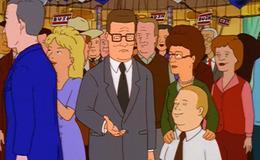I had two weeks off work recently and much to my wife’s chagrin I spent it watching whole seasons of my favourite sitcoms in a single sitting. Among the miasma of single New Yorkers and ugly guys with hot wives one show stayed in my memory, Mike Judge’s animated sitcom King of the Hill. It’s an underrated programme which won two Emmys and ran for 13 seasons, longer than even Friends or Seinfeld. What made the show standout was its low key, realistic approach to comedy. This wasn’t 22 minutes of redneck stereotypes but a show with a defined sense of place and character. Judge and co-creator Greg Daniels kept the show grounded for more than a decade, striving to find humour in the conventional and ultimately creating what Time TV critic James Poniewozik called “The most acutely observed, realistic sitcom about regional American life bar none”.
What most differentiated King of the Hill from its cartoon contemporaries was its setting. Arlen always remained a mid-sized Texan town. It didn’t suddenly gain plot relevant casinos like Spingfield or be destroyed Mecha-Streisands like South Park. Unlike time travelling Stewie Griffin or globe-trotting Eric Cartman, the furthest Bobby Hill ever strayed from Texas was New Orleans.
The show’s writer’s maintained this authenticity taking a biannual excursion to Austin to talk to residents and visit locations such as propane dealerships and mega churches. The details gleaned on these trips allowed King of the Hill to nurture what Los Angeles Times writer Paul Brownfield called “a sense of an actual world”. Rather than constricting the creativity of the writers, this well-defined “world” allowed for plots that may not have been considered by the Californian-based writing staff.

To further illustrate the show’s uniqueness, compare this season 5 joke about George W. Bush
with a Family Guy gag.
The former is a significant plot point in the episode while the later is a joke for joke’s sake. This is not to criticise Seth McFarlane (I personally laughed louder at the Family Guy joke) but to simply highlight the contrasting approaches. King of the Hill derived humor from characters’ reactions to the plot rather than on cutaway gags favoured not only by Family Guy but also by live action sitcoms like 30 Rock and How I Met Your Mother.
In fact King of The Hill’s commitment to realism was even greater than many flesh and blood programs. Hank Hill’s job selling propane and propane accessories
was a fertile source of humour, unlike sitcoms like Friends or Frasier, where work was something to moan about while spending endless hours in coffee shops or apartments they couldn’t possibly afford.
As well as finding humour in employment, Mike Judge and Greg Daniels were also willing to tackle a subject many other sitcoms could not even acknowledge, let alone joke about: race. Peggy’s career as a Spanish teacher brought her in contact with the nation’s sizeable Hispanic population, John Redcorn explored our attitudes towards Native Americans and the Souphanousinphones were a nod to Texas’ Laotian community, the second biggest in the country. This is far more representative of 21st Century America than comedies like Seinfeld or Girls which, despite being set in multicultural New York, are almost exclusively white.
Anyone who has read Mark Twain or listened to Jerry Seinfeld would not be shocked that as much humor could be found in a realistic situation as an absurd one. What is surprising is that it took a cartoon – a medium better known for talking animals and wacky situations – to create such an accurate portrait of American life. One man not surprised was Daniels, who spoke of his goals in a newspaper interview the year the show debuted. “I just think that animation has an enormous kind of unexplored area of realism,” he said.” People usually think of animation as superheroes or talking animals. And it’s just a great medium to do realistic human stories, also.”
(c) 2014, Ben Anderson
Ben Anderson is a journalist with a Bachelor of Arts from Curtin University. Like most Fijian-born Australians of Scottish descent, he loves American sit-coms. Ben has been published by
Cracked and the Australian Broadcasting Corporation and blogs at www.madasaspoon.wordpress.com.
As well as writing, Ben enjoys acting, watching other people play sport and writing short biographies about himself.
